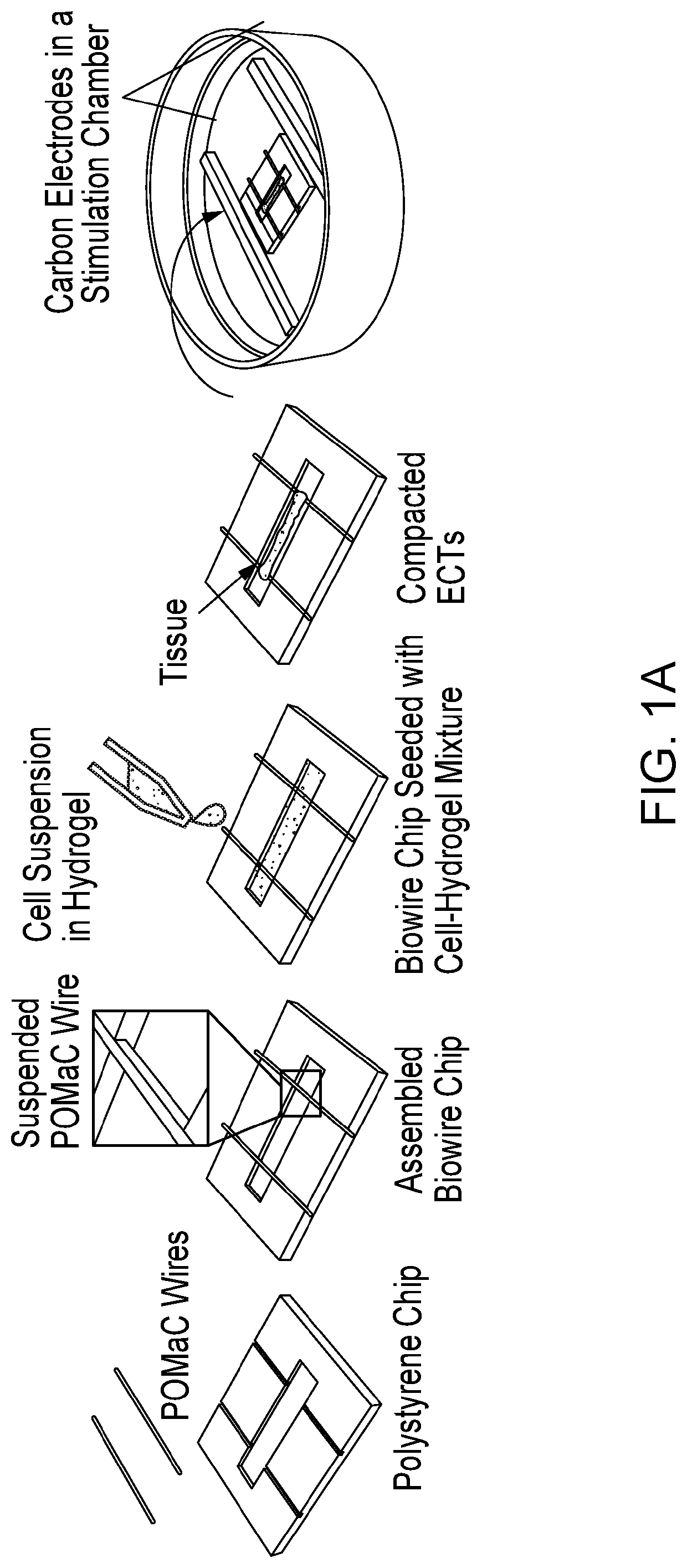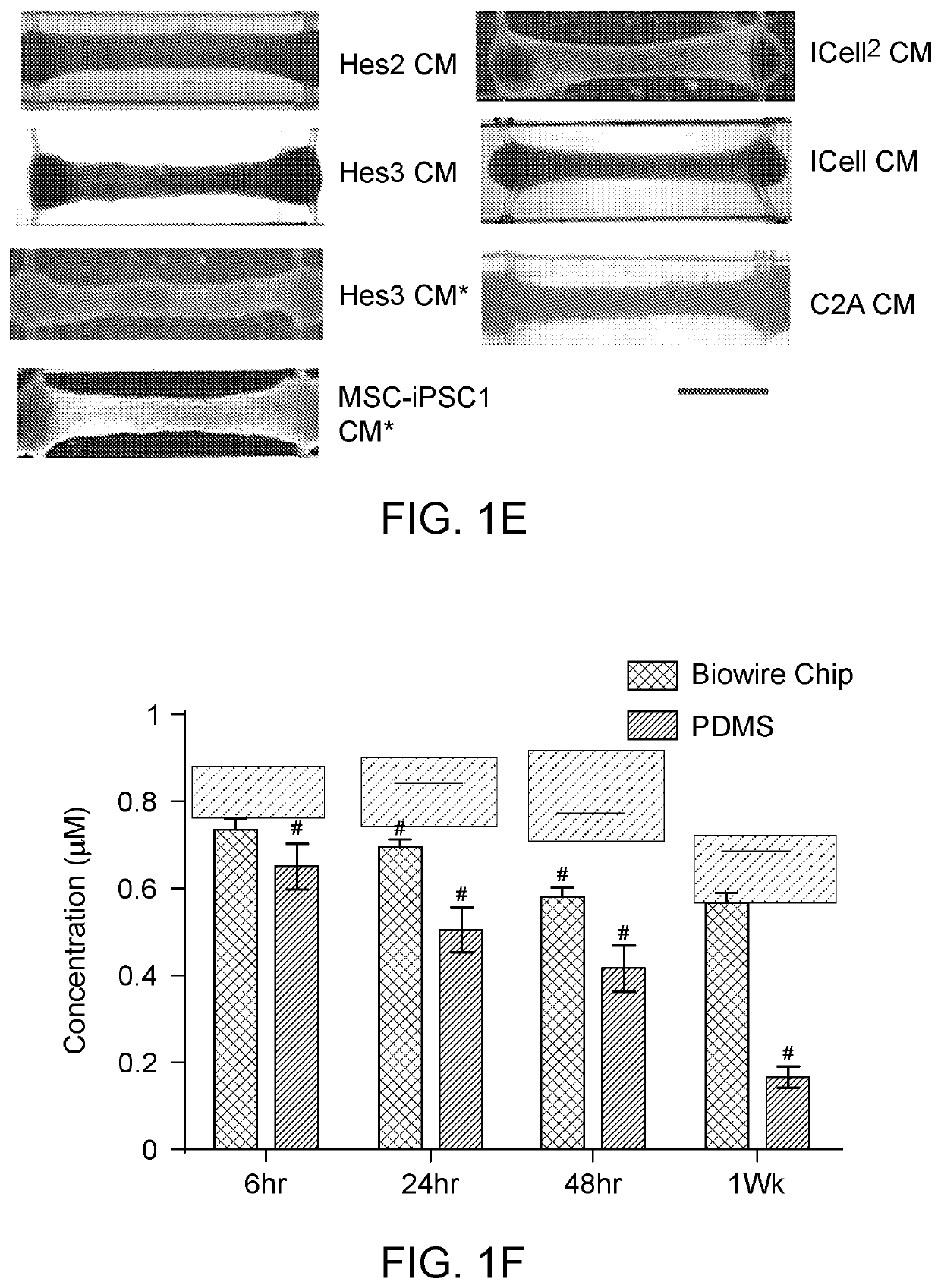Methods for tissue generation
a tissue and tissue technology, applied in the field of tissue generation, can solve the problems of sudden cardiac death, limited success of current treatment approaches, and inadequate platform for atrial drugs in the human ventricular myocardium, and achieve the effect of improving electrical function
- Summary
- Abstract
- Description
- Claims
- Application Information
AI Technical Summary
Benefits of technology
Problems solved by technology
Method used
Image
Examples
example 1
and Methods
[0267]Predominantly ventricular cardiomyocytes (CMs) were derived from the human embryonic stem cell (hESC) lines Hes2 and HES3-NKX2-5gfp / w using the using embryoid body (EB) differentiation protocol and the human induced pluripotent stem cell (hiPSC) line BJ1D using the monolayer differentiation protocols as previously described. Ventricular cell populations contained 74.7±6.3% (n=9) of CMs on average, based on cardiac troponin T expression analysis using flow cytometry, at the end of directed differentiation protocols.
[0268]C2A hiPSC derived cardiomyocytes were differentiated with EB protocol as previously described.
[0269]iCell and iCell2 cardiomyocytes were purchased from CDI and used according to the manufacturer's instructions.
[0270]Cardiomyocytes of Non-affected A, Non-affected B, Non-Affected C, affected D, affected E, and affected F were provided by Cellular Dynamics Inc, Madison, Wis.
[0271]Predominantly atrial cardiomyocytes were derived from Hes3-NKX2-5gfp / w hES...
example 2
[0323]Generating Heart Tissues From Multiple Cell Sources
[0324]FIG. 1A and FIG. 8A illustrate the general features of our “Biowire” platform which consists of an array of microwells (5 mm×1 mm×0.3 mm) patterned onto polystyrene sheets. Two flexible wires manufactured from a POMaC polymer are secured with adhesive glue along either end of the microwells. Myocardial tissues are created by combining 100,000 CMs (either ventricular or atrial or both) and cardiac fibroblasts (usually at a 10:1 ratio) with hydrogel within the microwells. During the next ˜7 days, cells undergo “compaction” thereby forming cylindrical trabecular strips (called Biowires II) that are suspended in the microwell but physically attached to the POMaC wires (FIGS. 8A, 8C, and 8D). Beginning at 1 week, the suspended Biowires are electrically conditioned for weeks with electrical field stimulation via a pair of carbon electrodes connected to a stimulator with platinum wires (FIG. 8A).
[0325]Details of the conditionin...
example 3
[0459]We investigated the impact of four microenvironmental cues: cell seeding density, types and percentages of non-myocyte populations, the types of hydrogels used for tissue inoculation and the electrical conditioning regimes on the structural and functional assembly of human pluripotent stem cell-derived cardiac tissues. Utilizing a heart-on-a-chip system that is capable of continuous non-invasive monitoring of tissue contractions, we were able to study how different micro-environmental cues affect the assembly of the cardiomyocytes into a functional cardiac tissue. We have defined conditions that resulted in tissues exhibiting hallmarks of the mature human myocardium, such as positive force-frequency relationship and post-rest potentiation.
[0460]Our goal here was to characterize and optimize a user-friendly organ-on-a-chip platform for the cultivation of human pluripotent stem cell-derived cardiac tissues. Unlike common organ-on-a-chip platforms, the described chip is construct...
PUM
| Property | Measurement | Unit |
|---|---|---|
| length | aaaaa | aaaaa |
| frequency | aaaaa | aaaaa |
| frequency | aaaaa | aaaaa |
Abstract
Description
Claims
Application Information
 Login to View More
Login to View More - R&D
- Intellectual Property
- Life Sciences
- Materials
- Tech Scout
- Unparalleled Data Quality
- Higher Quality Content
- 60% Fewer Hallucinations
Browse by: Latest US Patents, China's latest patents, Technical Efficacy Thesaurus, Application Domain, Technology Topic, Popular Technical Reports.
© 2025 PatSnap. All rights reserved.Legal|Privacy policy|Modern Slavery Act Transparency Statement|Sitemap|About US| Contact US: help@patsnap.com



